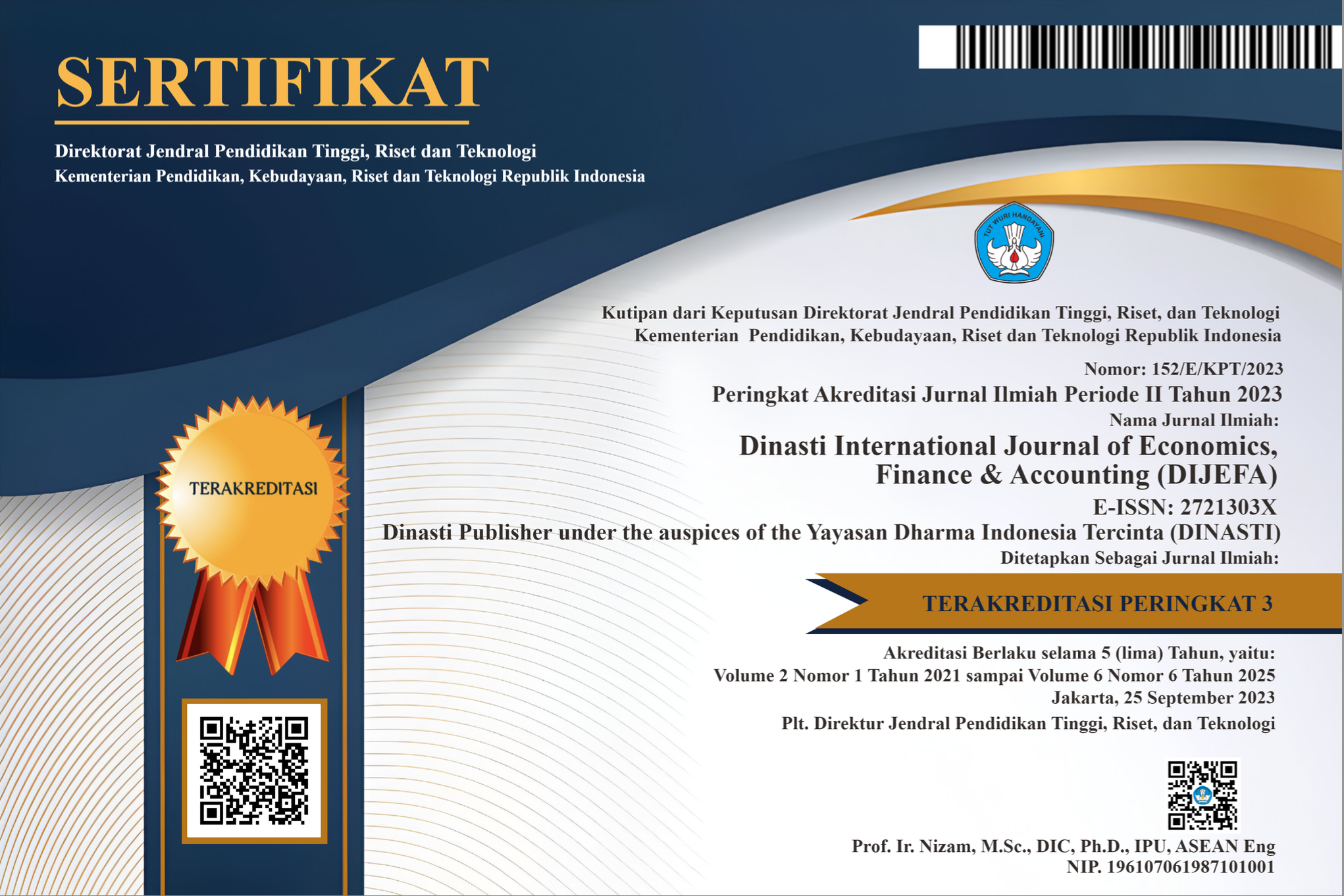The The Influence of Fiscal Policy, Monetary Policy and International Trade on Economic Growth in Indonesia (Literature Reviews)
DOI:
https://doi.org/10.38035/dijefa.v4i3.1923Keywords:
Economic Growth, Fiscal Policy, Monetary Policy, International TradeAbstract
The Literature Review article on the Influence of Fiscal Policy, Monetary Policy and International Trade on Economic Growth in Indonesia is a scientific article that aims to build a research hypothesis on the influence of variables to be used in further research, within the scope of public finance science. The way of writing this Literature Review article is the library research method, which is sourced from online media such as Google Scholar, Mendeley and other academic online media. The outcomes of this literature review study are: 1) Fiscal Policy influences Economic Growth in Indonesia; 2) Monetary Policy affects Economic Growth in Indonesia; and 3) International Trade has an effect on Economic Growth in Indonesia.
References
Acemoglu, D., & Robinson, J. A. (2012). The origins of power, prosperity, and poverty. New York (US): Crown Business.
Aimon, H., & Syofyan, E. (2014). Analisis Pengaruh Kebijakan Moneter Terhadap Inflasi Dan Perekonomian Di Indonesia. Jurnal Kajian Ekonomi, 2(4).
Akalpler, E., & Duhok, D. (2018). Does monetary policy affect economic growth: evidence from Malaysia. Journal of Economic and Administrative Sciences.
Apriesa, Lintantia Fajar & Miyasti. (2013). Pengaruh Desentralisasi Fiskal terhadap Pertumbuhan Ekonomi Daerah dan Ketimpangan Pendapatan(Studi Kasus: Kabupaten/Kota Jawa Tengah). Diponegoro Journal of Economics Volume 2, Nomor 1, Tahun 2013.
Arfiani, I.S. (2019). Analisis Empiris Hubungan antara Ekspor, Impor, Nilai Tukar dan Pertumbuhan Ekonomi di Indonesia. Jurnal Ekonomi Pembangunan, 17(2): 81-98.
Auzina, E. Astra. (2014). “Labor Productivity, Economic Growt and Global Competitivenes in Post Crisis Period”. 19th Internasional Scientific conference : Economic and Management”. Procedia-Social and Behavior Sciennces.Hal : 317-321.
Basuki, A. T., Purwaningsih, Y., Soesilo, A. M., & Mulyanto, M. (2020). The Effect of Fiscal Policy and Foreign Direct Investment on Regional Economy in Indonesia. Jurnal Ekonomi & Studi Pembangunan, 21(1), 53-68.
Barro, R. J. (1991). Economic growth in a cross section of countries. The quarterly journal of economics, 106(2), 407-443.
Bernanke, B. S., Boivin, J., & Eliasz, P. (2005). Measuring the effects of monetary policy: a factor-augmented vector autoregressive (FAVAR) approach. The Quarterly journal of economics, 120(1), 387-422.
Cabalu, H., & Alfonso, C. (2007). Does AFTA create or divert trade?. Global Economy Journal, 7(4).
Dollar, D., & Kraay, A. (2004). Trade, growth, and poverty. The economic journal, 114(493), F22-F49.
Dornbusch, R., Fischer, S., & Startz, R. (2004). Income and Spending. Macroeconomics, 216-223.
Easterly, W. (2001). The middleclass consensus and economic development. Journal of economic growth, 6(4), 317-335.
Fitriani, E. (2019) Pengaruh Perdagangan Internasional Terhadap Pertumbuhan Ekonomi Indonesia. Jurnal Riset Bisnis dan Manajemen, 9(1):16-26.
Feenstra, R. C., & Hanson, G. H. (2005). Ownership and control in outsourcing to China: Estimating the property-rights theory of the firm. The Quarterly Journal of Economics, 120(2), 729-761.
Frankel, J. A., & Romer, D. (1999). Does trade cause growth?. American economic review, 89(3), 379-399.
Gulo, A. (2008). Analisis pengaruh aspek moneter dan fiskal terhadap pertumbuhan ekonomi Indonesia. VISI (2008). 16 (3).
Hadiwibowo, Y. (2010). Fiscal policy, investment and long-run economic growth: Evidence from Indonesia. Asian Social Science, 6(9), 3.
Harahap, E. F., Luviana, L., & Huda, N. (2020). Tinjauan Defisit Fiskal, Ekspor, Impor Dan Jumlah Umkm Terhadap Pertumbuhan Ekonomi Indonesia. Jurnal Benefita, 5(2), 151-161.
Hariyanti, D., & Soeharjoto, V. (2022, January). Impact of Monetary Policy on Indonesia's Economic Growth, Case Studies before and during the Covid-19 Pandemic. In Proceedings of the First Lekantara Annual Conference on Public Administration, Literature, Social Sciences, Humanities, and Education, LePALISSHE 2021, August 3, 2021, Malang, Indonesia.
Haq, M., & Luqman, M. (2014). The contribution of international trade to economic growth through human capital accumulation: Evidence from nine Asian countries. Cogent Economics & Finance, 2(1), 947000.
Hill, Charles W.L., Chow-Hou Wee, Krishna Udayasnakar (Penerjemah Catur Sugiarto dan Ratna Saraswati). (2014). Bisnis Internasional: Perspektif Asia. Jakarta: Salemba Empat.
Hill, R. C., Griffiths, W. E., & Lim, G. C. (2018). Principles of econometrics. John Wiley & Sons.
Hussain, M. I., & Zafar, T. (2018). The interrelationship between money supply, inflation, public expenditure and economic growth. European Online Journal of Natural and Social Sciences, 7(1), pp-1.
Ismal, R. (2011). Assessing economic growth and fiscal policy in Indonesia. Journal of Economics and Business, 14(1), 53-71.
Krugman, P. (1995). Dutch tulips and emerging markets. Foreign Aff., 74, 28.
Leitão, N. (2013). A PANEL DATA MODELLING OF AGGLOMERATION AND GROWTH: CROSS-COUNTRY EVIDENCE. Theoretical and Empirical Researches in Urban Management.
Malik, Abdul., & Denny Kurnia. (2017). Pengaruh Utang Luar Negeri dan Penanaman Modal Asing terhadap Pertumbuhan Ekonomi. Jurnal Akuntansi. Vol. 3 No. 2.
Manik, M. (2022). Pengaruh Perdagangan Internasional Terhadap Pertumbuhan Ekonomi Indonesia. E-Mabis: Jurnal Ekonomi Manajemen dan Bisnis, 23(2), 13-20.
Mankiw, N. G. (2014). Principles of economics. Cengage Learning.
Ma’ruf, A., & Wihastuti, L. (2008). Pertumbuhan ekonomi indonesia: determinan dan prospeknya. Jurnal Ekonomi & Studi Pembangunan, 9(1), 44-55.
Mishkin, F. S. (2017). Rethinking monetary policy after the crisis. Journal of International Money and Finance, 73, 252-274.
Musa, Y., & Asare, B. K. (2013). Long and short run relationship analysis of monetary and fiscal policy on economic growth in Nigeria: a VEC model approach. Research Journal of Applied Sciences, Engineering and Technology, 5(10), 3044-3051.
Nawaz, S., & Khawaja, M. I. (2019). Fiscal policy, institutions and growth: New insights. The Singapore Economic Review, 64(05), 1251-1278.
Nursini, N. (2017). Effect of fiscal policy and trade openness on economic growth in Indonesia: 1990-2015. International Journal of Economics and Financial Issues, 7(1), 358-364.
Prihatin, W. A., Arintoko, A. A., & Siharno, S. S. (2019). Analisis Pengaruh Variabel-Variabel Moneter Terhadap Pertumbuhan Ekonomi Indonesia. Jurnal Ekonomi, Bisnis, dan Akuntansi, 21(3).
Putri, Y. E., Amar, S., & Aimon, H. (2015). Analisis faktor-faktor yang mempengaruhi pertumbuhan ekonomi dan ketimpangan pendapatan di Indonesia. Jurnal Kajian Ekonomi, 3(6).
Qasim, A. W., Kemal, M. A., & Siddique, O. (2015). Fiscal consolidation and economic growth: A case study of Pakistan. PIDE.
Romer, C. D., & Romer, D. H. (2013). The most dangerous idea in federal reserve history: Monetary policy doesn't matter. American Economic Review, 103(3), 55-60.
Raki?, B., & Ra?enovi?, T. (2013). The effectiveness of monetary and fiscal policy in Serbia. Industrija, 41(2).
Sachs, J. D., Warner, A., Åslund, A., & Fischer, S. (1995). Economic reform and the process of global integration. Brookings papers on economic activity, 1995(1), 1-118.
Saliba, E., Sayegh, W., & Salman, T. F. (2017). Assessing Labor Income Inequality in Lebanon's Private Sector Findings, Comparative Analysis of Determinants, and Recommendations. UNDP Fiscal Policy Advisory and Reform Project at the Lebanese Ministry of Finance. UNDP Fiscal Policy Advisory and Reform Project at the Lebanese Ministry of Finance Report.
Samuelson, P. A., & Nordhaus, W. D. (2010). Economics. 19th (Special Indian) ed.
Sahyanah, N. (2019). Analisis Dampak Perdagangan Internasional Terhadap Pertumbuhan Ekonomi Di Indonesia Tahun 2004-2017 Dalam Perspektif Ekonomi Islam (Doctoral dissertation, UIN Raden Intan Lampung).
Sari, A. P. (2017). Analisis kemandirian fiskal daerah Kota Batu dilihat dari perkembangan pendapatan asli daerah tahun 2009-2013 (Doctoral dissertation, Universitas Negeri Malang).
Seprillina, L., & Ismail, M. (2012). Efektivitas Instrumen Kebijakan Moneter Terhadap Pertumbuhan Ekonomi di Indonesia (Periode 1999: 1–2012: 2). Jurnal Ilmiah Mahasiswa FEB, 1(2).
Simorangkir, I., & Adamanti, J. (2010). The role of fiscal stimulus and monetary easing in Indonesian economy during global financial crisis: Financial computable general equilibrium approach. Bulletin of Monetary Economics and Banking, 13(2), 165-186.
Vijayasri, G. V. (2013). The importance of international trade in the world. International Journal of Marketing, Financial Services & Management Research, 2(9), 111-119.
Widodo, S. (2020). PENGARUH INDEKS KAPASITAS FISKAL (IKF) DAN INDEKS RUANG FISKAL (IRF) TERHADAP DANA PERIMBANGAN TAHUN 2015-2020 PADA 122 KABUPATEN DAERAH TERTINGGAL DI INDONESIA. Jurnal Budget: Isu dan Masalah Keuangan Negara, 5(1), 30-46.
Winarto, H., Poernomo, A., & Prabawa, A. (2021). Analisis Dampak Kebijakan Moneter terhadap Pertumbuhan Ekonomi di Indonesia. J-MAS (Jurnal Manajemen dan Sains), 6(1), 34-42.
Wulandari, L., & Zuhri, S. (2019). Pengaruh perdagangan internasional terhadap pertumbuhan ekonomi Indonesia Tahun 2007-2017. Jurnal REP (Riset Ekonomi Pembangunan), 4(2), 1-189.
Yuni, R., & Hutabarat, D. L. (2021). Dampak Perdagangan Internasional Terhadap Pertumbuhan Ekonomi Indonesia Pada Tahun 2009-2019.
Zee, H. H. (1996). Fiscal Policy and Long-Run Growth.
Downloads
Published
How to Cite
Issue
Section
License
Authors who publish their manuscripts in this journal agree to the following conditions:
- The copyright on each article belongs to the author(s).
- The author acknowledges that the Dinasti International Journal of Economics, Finance & Accounting (DIJEFA) has the right to be the first to publish with a Creative Commons Attribution 4.0 International license (Attribution 4.0 International (CC BY 4.0).
- Authors can submit articles separately, arrange for the non-exclusive distribution of manuscripts that have been published in this journal into other versions (e.g., sent to the author's institutional repository, publication into books, etc.), by acknowledging that the manuscript has been published for the first time in the Dinasti International Journal of Economics, Finance & Accounting (DIJEFA).


























































